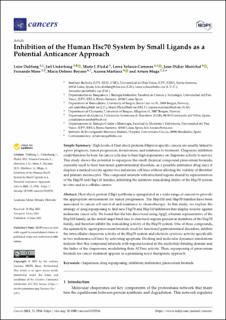| dc.contributor.author | Dublang, Leire | |
| dc.contributor.author | Underhaug, Jarl | |
| dc.contributor.author | Flydal, Marte Innselset | |
| dc.contributor.author | Velasco-Carneros, Lorea | |
| dc.contributor.author | Maréchal, Jean-Didier | |
| dc.contributor.author | Moro, Fernando | |
| dc.contributor.author | Boyano, Maria Dolores | |
| dc.contributor.author | Martinez, Aurora | |
| dc.contributor.author | Muga, Arturo | |
| dc.date.accessioned | 2022-01-20T08:51:09Z | |
| dc.date.available | 2022-01-20T08:51:09Z | |
| dc.date.created | 2021-12-15T09:20:38Z | |
| dc.date.issued | 2021 | |
| dc.identifier.issn | 2072-6694 | |
| dc.identifier.uri | https://hdl.handle.net/11250/2838404 | |
| dc.description.abstract | Heat shock protein (Hsp) synthesis is upregulated in a wide range of cancers to provide the appropriate environment for tumor progression. The Hsp110 and Hsp70 families have been associated to cancer cell survival and resistance to chemotherapy. In this study, we explore the strategy of drug repurposing to find new Hsp70 and Hsp110 inhibitors that display toxicity against melanoma cancer cells. We found that the hits discovered using Apg2, a human representative of the Hsp110 family, as the initial target bind also to structural regions present in members of the Hsp70 family, and therefore inhibit the remodeling activity of the Hsp70 system. One of these compounds, the spasmolytic agent pinaverium bromide used for functional gastrointestinal disorders, inhibits the intracellular chaperone activity of the Hsp70 system and elicits its cytotoxic activity specifically in two melanoma cell lines by activating apoptosis. Docking and molecular dynamics simulations indicate that this compound interacts with regions located in the nucleotide-binding domain and the linker of the chaperones, modulating their ATPase activity. Thus, repurposing of pinaverium bromide for cancer treatment appears as a promising novel therapeutic approach. | en_US |
| dc.language.iso | eng | en_US |
| dc.publisher | MDPI | en_US |
| dc.rights | Navngivelse 4.0 Internasjonal | * |
| dc.rights.uri | http://creativecommons.org/licenses/by/4.0/deed.no | * |
| dc.title | Inhibition of the Human Hsc70 System by Small Ligands as a Potential Anticancer Approach | en_US |
| dc.type | Journal article | en_US |
| dc.type | Peer reviewed | en_US |
| dc.description.version | publishedVersion | en_US |
| dc.rights.holder | Copyright 2021 by the authors. | en_US |
| dc.source.articlenumber | 2936 | en_US |
| cristin.ispublished | true | |
| cristin.fulltext | original | |
| cristin.qualitycode | 1 | |
| dc.identifier.doi | 10.3390/cancers13122936 | |
| dc.identifier.cristin | 1968629 | |
| dc.source.journal | Cancers | en_US |
| dc.relation.project | Norges forskningsråd: 245922 | en_US |
| dc.relation.project | Helse Vest RHF: 912246 | en_US |
| dc.relation.project | Norges forskningsråd: 261826 | en_US |
| dc.identifier.citation | Cancers. 2021, 13 (12), 2936. | en_US |
| dc.source.volume | 13 | en_US |
| dc.source.issue | 12 | en_US |

